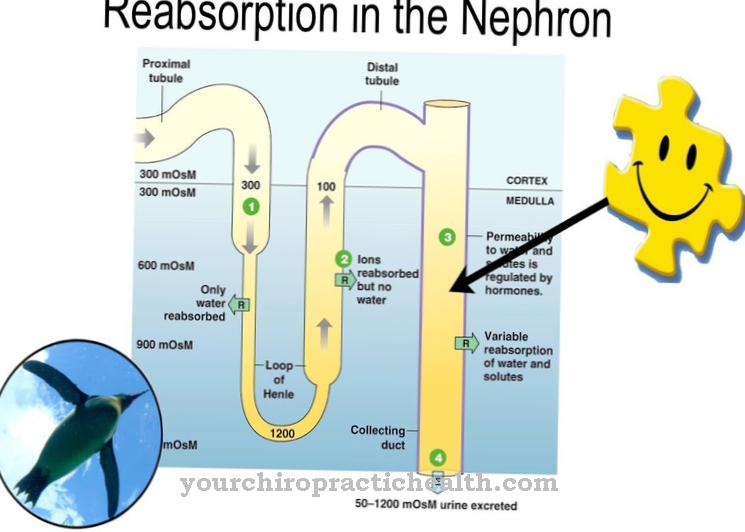The Evaporation is part of the thermoregulation that keeps the body temperature of warm-blooded animals constant. The evaporation process is also known as the evaporation process and is triggered by a lowered sympathetic tone when it is hot. Increased evaporation is a condition also known as hyperhidrosis.
What is evaporation?

Evaporation takes place within the framework of thermoregulation. All processes with which the body of a warm-blooded animal keeps the body temperature constant at the level that provides the ideal working temperature for body processes such as the blood circulation are called thermoregulation. This requires permanent heat exchange with the environment.
This heat exchange takes place through various body mechanisms. In addition to evaporation, convection, conduction and radiation are among the body's own mechanisms of heat exchange. Conduction is the exchange of heat through direct contact. Convection is the heat exchange via an exchange medium such as air. Medicine understands radiation to be heat radiation in the form of electromagnetic waves and evaporation is the loss of heat through evaporation processes. Liquids are thickened by removing water from them using a vacuum.
Function & task
Through evaporation, the human body temperature is maintained despite high ambient temperatures. The loss of heat through evaporation cools the body. In the event of overheating as a result of high ambient temperatures, the thermoregulatory center in the hypothalamus lowers the tone of the sympathetic nervous system. This lowering is the first step in thermoregulation and requires permanent temperature control by peripheral and visceral thermoreceptors.
These are the free nerve endings of the sensitive neurons that are in the skin and mucous membranes. They measure the external and internal temperatures and transmit their signals centrally through neural convergences, which are summed up in the first neuron and travel along the spinothalamic tract. In this way they reach the thalamus and are switched to the second neuron.
The second neuron terminates with its projection fibers in the area of the hypothalamus. As the central control center for body temperature, the hypothalamus receives permanent information inputs. Using the temperature data, he compares it and, if necessary, responds to it with regulatory processes to keep the body temperature constant.
Heat causes the hypothalamus to lower the tone of the sympathetic nervous system. This lowering of the tone triggers regulatory reactions. One response to the tonally decreasing change is peripheral vasodilation. The second reaction mechanism is increased sweat secretion.
The peripheral vasodilation corresponds to a widening of the vessels in the peripheral blood vessels. This results in improved blood circulation in the extremities. The heat exchange surface is enlarged and larger heat losses can take place through convection. The sweat secretion takes place through the sympathetically cholinergic innervated sweat glands, which are also known as the glandulae sudoriferae. They increase their secretion by increasing the sympathetic tone. Evaporation of sweat creates what is known as evaporation cold and the skin is cooled. This process corresponds to evaporation.
You can find your medication here
➔ Medicines for cold feet and handsIllnesses & ailments
Increased evaporation accompanies a large number of clinical pictures. As a rule, these clinical pictures are linked to a fever, which is lowered by the body through evaporation. However, the evaporation itself can also assume pathological proportions. It then does not appear as a symptom of a primary disease, but is a primary disease itself.
One of the most well-known diseases in this context is hyperhidrosis. This phenomenon corresponds to a genetic predisposition to profuse sweating, which is mostly limited locally to a certain area of the body. The arms, armpits, feet or hands in particular are often affected by hyperhidrosis. In principle, however, hyperhidrosis can also affect the entire body. Usually the underlying cause of such a phenomenon is an overfunction of the local sweat glands.
What stimulates the sweat glands to become overactive is often unclear. Stress and psychological problems can play just as big a role in the clinical picture as hyperthyroidism. Above all, stress and psychological over-functions are a vicious circle, as the sweats usually make those affected feel even more stress and thus have a negative effect on the psyche.
Dyshidrosis is also a well-known disease that is related in the broadest sense to evaporation. In this condition, small, fluid-filled blisters form that cause significant itching. Dyshidrosis often accompanies hyperhidrosis, although medicine has so far been unsure of the connection.
Since various drugs also influence thermoregulation and evaporation, some hyperhidroses and the dyshidroses that occur with them are drug-related and can therefore not be directly called a disease, but are rather a side effect.
A change in the hypothalamus or sympathetic nervous system can also cause problems with evaporation. Such changes can be tumors in these brain regions, for example. Diseases of the central nervous system are also possible causes of changes in these brain regions. If the tone of the sympathetic nervous system remains permanently at a low level due to dysregulation, for example, excessive sweating can set in despite cold temperatures. The consequences of such a phenomenon are manifold and make it difficult for the body to maintain body temperature. The phenomenon can thus have a negative effect on all temperature-dependent body processes.



























